#Jacques Necker
Text
“Only fools, pure theorists, or apprentices fail to take public opinion into account.”

Jacques Necker was a Genevan banker and statesman who served as finance minister for Louis XVI. He was a reformer, but his innovations sometimes caused great discontent.
Born: 30 September 1732, Geneva, Switzerland
Died: 9 April 1804, Geneva, Switzerland
Swiss Origins: Necker was born in Geneva, Switzerland, in 1732. His Swiss background made him a foreigner in the French political landscape, and this sometimes influenced the perception of his policies.
Self-Financed Publication: Necker was known for his publication titled "Compte Rendu," or "Report on the Finances." This document, which detailed the state of France's finances, was unique in that Necker personally financed its publication. This move aimed to showcase transparency and gain public support.
Resignation through Illness: In 1781, Necker resigned from his position as Finance Minister, citing health reasons. His resignation was accepted, but he continued to influence French politics from behind the scenes. He was later recalled to office in 1788.
Criticized by Revolutionaries: Despite being initially celebrated for his efforts to improve financial transparency, Necker faced criticism from revolutionary figures like Maximilien Robespierre. They accused him of being too sympathetic to the monarchy and not fully supporting the revolutionary cause.
Exile in Switzerland: After the fall of the Bastille in 1789 and the escalation of the French Revolution, Necker resigned once again. Fearing for his safety, he sought refuge in Switzerland. His departure marked the end of his active political career.
#Jacques Necker#French Revolution#Finance Minister#Louis XVI#Economic Reforms#Enlightenment#Transparency in Government#Swiss Banker#Statesman#Political Reform#Public Finances#1789 Crisis#National Assembly#Royal Finances#Dismissal from Office#Necker Reports#French Monarchy#Social Unrest#Financial Management#Legacy of Jacques Necker#quoteoftheday#today on tumblr
1 note
·
View note
Text
Zin in revolutie. Robert Darnton over Parijs 1748-1789
De bestorming van de Bastille op 14 juli 1789 – die geldt als het begin van de Franse revolutie – was niet uitsluitend, of zelfs maar in geringe mate het gevolg van de filosofische inzichten van Montesquieu, Voltaire, d’Alembert, Rousseau of andere denkers van de Verlichting – meent de Amerikaanse historicus Robert Darnton. Ook andere, meer structurele problemen als de opkomst van een moderne…

View On WordPress
#1789#Achttiende Eeuw#Arlette Farge#ballonvaart#Bastille#Calonne#Foucault#François-Hubert Drouais#Franse revolutie#Gazette de leyde#Jacques Necker#Jean-Pierre Houël#Lettre de cachet#Lodewijk XV#Lodewijk XVI#Madame de Pompadour#Madame de Staël#Madame du Barry#Marie Antoinette#Nesle#Parlement de Paris#Robert Darnton#Robert Paxton#Versailles#Voltaire
0 notes
Note
hey loser. 1789 called
LMAOOOOOO
4 notes
·
View notes
Text

#Suite Necker es el apartamento privado de Jacques Necker#el ministro de finanzas y estadista de la Revolución Francesa.Sirviendo a Louis XVI
4 notes
·
View notes
Text
A brief history of Camille Desmoulins
It's March 2nd today, which means it's the birthday of my biggest writing muse: Camille Desmoulins, 18th-century journalist, French revolutionary and the man who called the Parisian people to arms, resulting in the Storming of the Bastille.
Despite essentially causing such a major historical event, Camille is largely glossed over by historians, and not many people know about him as a result. However, that doesn't mean he didn't have any influence on the revolution, and he contributed to it the same way as famous personalities like Robespierre, Danton, and Saint-Just did. So, in honor of his 264th birthday, here's a little history of the man gracing my profile pic.
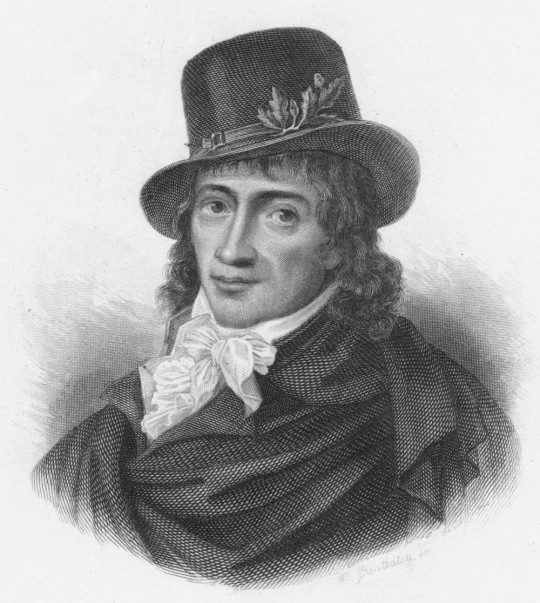
The early years
Camille was born in 1760, in the commune of Guise in the province of Picardy. At fourteen years of age, he obtained a scholarship to study at the Collège Louis-le-Grand in Paris, one of the most esteemed elite schools in France. There, he met Maximilien de Robespierre, and despite the boys being two years apart in age and having very different personalities - Maximilien was more calm and secluded, while Camille was lively and impulsive - the two bonded over their mutual love for classical history and philosophy.
After graduating from Louis-le-Grand, Camille began to pursue a career in law, being admitted to the Parlement of Paris in 1785. However, his stammer and lack of connections to the Parisian legal community impeded his success, so he instead took up writing as a journalist, with a primary focus on political affairs.
The Estates-General and the call to arms
When King Louis XVI convened the Estates-General in 1789, Camille was present at the procession on May 5th, writing a comment about the event. The Comte de Mirabeau, presenting himself as a middleman between the aristocracy and the Third Estate as well as a patron for Camille, even employed the latter as a writer for his newspaper for a time.
However, the mingling of the three estates was not well received by the king, and he tried to regain control over the members who had dubbed themselves the National Assembly by closing the Salle des Menus Plaisirs where the deputies met to them. Instead, the National Assembly held their meeting in the Jeu de Paume (which was normally used as the tennis court of Versailles), where the members from various estates swore the oath to not part until they had devised a new constitution for France.
Eventually, the king was forced to relent, but that didn't keep him from concentrating his troops in Versailles and Paris. When he dismissed finance minister Jacques Necker - who was very popular among the people and considered an advocate for their interests - the atmosphere in Paris took a turn for the worse.
The Parisians were angry, worried, and in fear, and in this situation - on July 12th, 1789 - Camille took the opportunity to leap onto a table in front of the Cafe de Foy in the Palais Royal. There, he delivered a passionate speech, even losing his usual stammer in the heat of the moment, calling the people to take up arms to defend themselves against the imminent massacre of the king's troops* and put on cockades so they recognize each other.
Following Camille's example, the people took green leaves from the trees lining the Palais Royal and stuck them to their coats. However, since green was associated with the Comte d'Artois, the conservative brother of the king, the color of the cockades quickly shifted to red and blue, the colors of the commune of Paris (white was added later to represent the king, in an attempt to reconcile the factions). Bad news for Camille's leaf cockades…
*The king most likely didn't plan to massacre the citizens, but the presence of so many troops, a good deal of them foreign, made the populace very anxious.
Journalistic career and the Girondins
After being present at the Storming of the Bastille, Camille continued to be politically active, publishing radical pamphlets and newspapers such as La France Libre, Discours de la lanterne aux Parisiens, and Révolutions de France et de Brabant. He joined the Club des Cordeliers led by Georges Danton and became part of the radical leftist Montagnards, the "Mountain" party of the National Convention, consisting of members such as Maximilien de Robespierre, Jean-Paul Marat, and Louis Antoine Saint-Just.
In 1790, Camille also married Lucile Duplessis, whom he had known for several years and harbored strong feelings for. However, despite Lucile's mother being a good friend of Camille's, her father repeatedly denied the couple his blessing, being of the opinion that Camille couldn't support a family with his meager income as a journalist. (Indeed, in the days prior to the revolution, Camille often had to live in poverty due to his difficulties establishing himself as a lawyer.) After gaining popularity as a journalist, however, Lucile's father finally allowed the lovers to marry, the marriage taking place on December 29th with Robespierre, Jacques Pierre Brissot, and Jérôme Pétion de Villeneuve being present as witnesses.
However, success and bliss were not meant to last: After the massacre at the Champs de Mars on July 17th, 1791, Camille had to go into hiding, putting his journalistic activities on halt for the time being. When he took up his work again in 1792, he wrote a few papers viciously attacking the political faction of the Girondins and specifically their leader, Jean Pierre Brissot. In his works, Camille accused them of betraying the republic and counter-revolutionary acts*, which majorly contributed to the arrest and subsequent execution of many Girondin leaders, including Brissot. However, Camille came to regret his role in their deaths: During the trial, he was lamenting "Oh my God! My God! It is I who killed them!", collapsing in the courtroom when the death sentence was announced.
*The Girondins had acquired a reputation of intending to harm the revolution with their actions, on one hand due to their pro-war attitude (the war with other European empires had taken its toll on the Republic of France), and on the other hand due to the party's indecisiveness concerning the judgement of the king (some of them argued for clemency or a milder punishment).
Vieux Cordelier and downfall
After 1793, Camille had a notable change of heart, becoming one of the voices in favor of clemency instead of terror. In what would become his most well-known and popular journal, Le Vieux Cordelier, he argued against imprisoning citizens based on the mere suspicion of counter-revolutionary activities, condemning the brutality of the Reign of Terror and even directly addressing his old friend Robespierre to moderate his approach.
However, this only ended up making Camille another prime target. Robespierre initially tried to defend Camille from the Jacobin Club calling for his expulsion, but this changed when Danton's secretary, Fabre d'Églantine, was exposed for financial fraud. This cast a poor light on Danton and his allies, including Camille, and it was what made Robespierre support legally persecuting them. Charges of corruption, royalist tendencies, and conspiracy against the revolution were brought forth against them, resulting in the arrest of Camille, Danton, and the rest of the Dantonists.
The trial itself took place from April 3rd to 5th, and was obviously aimed at getting rid of the political threat that Danton and his allies posed. By decree of the National Convention, the accused were not allowed to defend themselves, in addition to being denied the right to call any witnesses. The guilty verdict, which was essentially prescribed due to the nature of the trial, was passed in the absence of the defendants to prevent unrest in the courtroom, and the Dantonists were scheduled to ascend the scaffold on the very same day.
In Luxembourg prison, Camille wrote a last letter to his beloved wife Lucile, with spots from tears being visible to this day. However, it should never reach her, as Camille was informed that Lucile had also been arrested on his way to the scaffold. He went wild upon hearing the news, and it took several men to get him into the tumbrel. Of the fifteen Dantonists guillotined on April 5th, 1794, Camille was the third to die.
Lucile, who had been arrested on the charge of conspiring to free her husband, followed him only eight days later, being guillotined on April 13th, 1794. She left behind her not even two years old son, Horace Camille Desmoulins, who was raised by Lucile's mother and sister. In 1817, Horace emigrated from France to Haiti, where his gravestone can be found to this day.
And that is the story of Camille Desmoulins: the man who ignited the spark of the French Revolution, but eventually got disgusted by its brutality, leading to his tragic end.
Camille may be a bit overlooked as a historical figure, but that does not make him less interesting or important.
So, in all due honor: Happy birthday, Camille! 🎂
#french revolution#frev#camille desmoulins#lucile desmoulins#history#french history#joyeux anniversaire Camille! <3
81 notes
·
View notes
Text
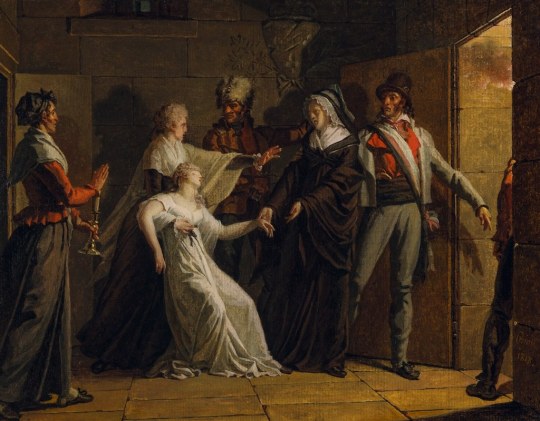
Jacques Augustin Pajou - Marie Antoinette séparée de sa famille au temple - 1818
Marie Antoinette (Marie Antoinette Josèphe Jeanne; 2 November 1755 – 16 October 1793) was the last queen of France prior to the French Revolution. She was born an archduchess of Austria, and was the penultimate child and youngest daughter of Empress Maria Theresa and Emperor Francis I. She became dauphine of France in May 1770 at age 14 upon her marriage to Louis-Auguste, heir apparent to the French throne. On 10 May 1774, her husband ascended the throne as Louis XVI and she became queen.
As queen, Marie Antoinette became increasingly unpopular among the people; the French libelles accused her of being profligate, promiscuous, having illegitimate children, and harboring sympathies for France's perceived enemies, including her native Austria. She was falsely accused in the Affair of the Diamond Necklace, but the accusations damaged her reputation further. During the French Revolution, she became known as Madame Déficit because the country's financial crisis was blamed on her lavish spending and her opposition to social and financial reforms proposed by Anne Robert Jacques Turgot and Jacques Necker.
Several events were linked to Marie Antoinette during the Revolution after the government placed the royal family under house arrest in the Tuileries Palace in October 1789. The June 1791 attempted flight to Varennes and her role in the War of the First Coalition were immensely damaging to her image among French citizens. On 10 August 1792, the attack on the Tuileries forced the royal family to take refuge at the Assembly, and they were imprisoned in the Temple Prison on 13 August. On 21 September 1792, the monarchy was abolished. Louis XVI was executed by guillotine on 21 January 1793. Marie Antoinette's trial began on 14 October 1793; she was convicted two days later by the Revolutionary Tribunal of high treason and executed, also by guillotine, at the Place de la Révolution.
Jacques-Augustin-Catherine Pajou (27 August 1766, Paris - 28 November 1828, Paris) was a French painter in the Classical style.
10 notes
·
View notes
Quote
¿Que se puede añadir a la felicidad de un hombre que tiene buena salud, no tiene deudas y cuenta con la conciencia limpia?
Adam Smith

Fue un economista y filósofo escocés, nacido en Kirkcaldy en junio de 1723, considerado uno de los mayores exponentes de la economía clásica y de la filosofía de la economía.
Fue el único hijo del segundo matrimonio de Adam Smith oficial de aduanas y Margaret Douglas.
Poco se sabe de su infancia a excepción de que fue raptado por una banda de gitanos a la edad de 4 años y fue rescatado por su tío.
A la edad de 14 años, Smith ingresó a la Universidad de Glasgow en donde fue influenciado por el famoso profesor de filosofía moral Francis Hutcheson. Después de su graduación en 1740, obtuvo una beca para Oxford en donde estudió 6 años en el Balliol College.
De regreso a casa en 1748 a 1761 fue profesor ayudante de las cátedras de retórica y literatura en Edimburgo y fue durante esas fechas que estableció una estrecha amistad con el filósofo David Hume, quien influyó en muchas de sus teorías económicas y éticas de Smith.
A partir de 1751 Smith ocupó la cátedra de lógica y de filosofía moral cargo que ejerció durante 12 años.
Smith publicó su primera obra en 1759 bajo el título de “Teoría de los sentimientos morales” la cual era parte de la segunda parte de su curso y que le hizo ganar gran reputación.
En 1783, el aristócrata Charles TownShend, ofreció a Smith una pensión vitalicia a cambio de encargarse de la educación de su hijastro durante un viaje de tres años por Suiza y Francia.
Durante este viaje conoció al economista francés Francois Quesnay y al cofundador de la escuela conocida como fisiocracia Ann Robert Jacques Turcot, los cuales servirían para que Smith pudiera construir su propia teoría, con diferencias respecto a la de estos autores.
También durante este viaje conoció a pensadores ilustrados como Voltaire, Benjamin Franklin, Diderot, al filósofo y enciclopedista francés D’alembert y al banquero Necker entre otros.
Al finalizar su viaje Smith regresó con su madre para dedicar la mayor parte de su tiempo a la elaboración de su obra “La riqueza de las naciones”, obra que intenta diferenciar la economía política de la ciencia política.
La riqueza de las naciones le llevó mas de 10 años escribirla y es por tal razón es que para algunos especialista Smith es considerado el padre de la economía política.
En 1779 viajó a Londres en donde fue duramente criticado por sus elogios a Hume y sus criticas a la religión.
A su regreso de Londres fue nombrado director de Aduana de Edimburgo en 1778, puesto que desempeñó hasta su muerte en 1790 a la edad de 67 años.
#frases#citas de escritores#notasfilosoficas#filosofía#citas de reflexion#Escocia#economia#citas de la vida
22 notes
·
View notes
Photo
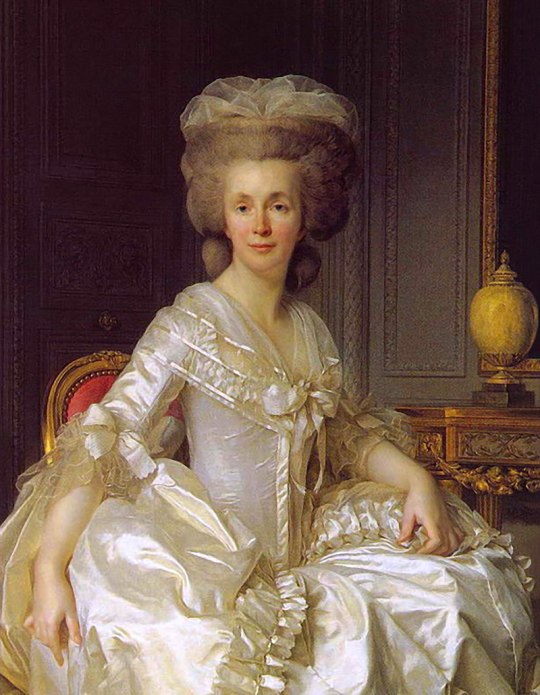
Suzanne Curchod (1737 – 6 May 1794) was a French-Swiss salonist and writer. She hosted one of the most celebrated salons of the Ancien Régime. She also led the development of the Hospice de Charité, a model small hospital in Paris that still exists today as the Necker-Enfants Malades Hospital. She was the wife of French finance minister Jacques Necker, and is often referenced in historical documents as Madame Necker.
24 notes
·
View notes
Text
Prese
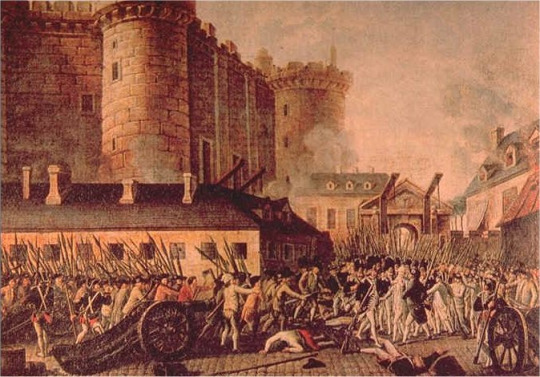
La primavera del 1789 in Francia fu meteorologicamente disastrosa: freddo fino a maggio, grandinate e piogge fortissime ridussero i campi in miseria. Il prezzo del pane raddoppiò e in tutta la Francia serpeggiava il sinistro sentore di carestia. Luigi XVI deve ricorrere al sostegno di Jacques Necker, politico ed economista svizzero, come ministro dell’economia. In primis, per cercare di arginare il malcontento popolare che mal digeriva lo sfarzo di corte a Versailles. Il suo principale tentativo è quello di ottenere la ripartizione egualitaria delle tasse. Le classi borghesi e popolari, riunite nel "Terzo Stato”, sono i ceti che soffrono maggiormente il peso tributario. Il 5 maggio 1789 viene indetta l’Assemblea degli Stati Generali. Sono passati ben 175 anni dall’ultima volta. Il “Terzo Stato” ha la maggioranza numerica di deputati, ma il suffragio si svolgerà non per voto pro capite, bensì per ordine sociale, soluzione quest’ultima che avvantaggerebbe l’alleanza fra clero e nobiltà. Ma il 20 giugno del 1789, il “Terzo Stato”, insieme ad una piccola percentuale di esponenti degli altri due ceti, decide di radunarsi a parte per costituire “L’Assemblea dei deputati della Nazione”. La loro autoproclamazione è di fatto un affronto al Re in persona. La soluzione politica che Luigi XVI aveva affidato al ministro Necker, è ormai irrealizzabile. La nuova Assemblea si ritira nella sala dedicata al gioco della palla corda, per proclamare un giuramento solenne. La destituzione del ministro delle Finanze Jaques Necker, da parte del sovrano Luigi XVI, è per Parigi la prova inconfutabile della congiura aristocratica, il segno della bancarotta e della controrivoluzione. Così la mattina del 14 luglio 1789 la popolazione parigina insorge, riversandosi nelle strade con una bandiera tricolore: nasce la drapeau française. Il rosso e il blu simboleggiano Parigi, il bianco è il colore della dinastia borbonica. Quella mattina settemila insorti attaccano l’armeria de l’Hotel Des Invalides. Il bottino è di quasi trentamila fucili e diversi cannoni, ma della polvere da sparo nessuna traccia. Il popolo però sa dove trovarla: a Saint Antoine, nel centro della città, dove sorge la fortezza della Bastiglia. Prende avvio l’assedio di questo tetro carcere, simbolo dell’Ancien Régime, costruito sotto il regno di Carlo V, che detiene al momento dell’insurrezione solo sette prigionieri: quattro falsari, il Conte di Solages e due folli. Annientata l’ultima resistenza delle guardie del comandante De Launay, la Bastiglia è presto conquistata da migliaia di rivoltosi. Luigi XVI, sconvolto, decide di riassumere il ministro Jacques Necker e spera in una tregua, ma la protesta è ormai dilagata nelle maggiori città del paese e non solo. Le notizie che giungono da Parigi, unite all’insostenibile condizione determinata da più di un decennio di recessione, spingono alla ribellione. A dare adito all’insurrezione è la rabbia accumulata, la carestia e la disperazione della popolazione francese. Con la presa della Bastiglia e il martirio dei parigini uccisi per la libertà, si accende la prima scintilla della Rivoluzione, un colpo violento che sarà il primo di una lunga serie. Da quel 14 luglio 1789, la rivolta, divenuta rivoluzione, ha trionfato sul potere assoluto, delineando le sorti di una Nazione. E, per la Francia così come per tutti i popoli dell’Europa, niente sarà più come prima.

15 notes
·
View notes
Text
La Fayette's taste in Books
I am always on the hunt for some primary historical documents that give a deeper insight into La Fayette’s private life and I found this invoice for a couple of books that he bought between mid-1829 and early 1830.

Daniels, Mary F. “The Lafayette Collection at Cornell.” The Quarterly Journal of the Library of Congress, vol. 29, no. 2, 1972, pp. 95–137. JSTOR, http://www.jstor.org/stable/29781504. Accessed 14 Feb. 2023.

A few titles are especially noteworthy. First, there is one book called “Mem[oirs] of Clinton” That are very likely the Memoirs of DeWitt Clinton, the former Governor of New York who had died in 1828 and whose Memoirs were published in 1829.

Than we have one book by Madame de Staël, a dear and long-time friend of La Fayette. Funny enough, de Staël was the daughter of Jacques Necker, former French minister of finances, and while La Fayette and de Staël had a very close relationship ... La Fayette and Necker’s relationship was less harmoniously.
We also see a book by Destutt de Tracy. He was not only a friend and colleague of La Fayette, no, the two were also in-laws. La Fayette’s son Georges had previously married de Tracy’s daughter.
The most interesting book on that list is probably “Lafayette en amérique.” The book was written by Auguste Levasseur, La Fayette’s secretary during his last visit to America in 1824/25, and published in 1829.
This list shows us La Fayette’s taste in books. The titles cover a wide range of subjects, some even with a personal connection. The books are written in both English and French (this list contains no Latin titles, but La Fayette read them as well.)
#marquis de lafayette#la fayette#dewitt clinton#madame de staël#destutt de tracy#auguste levasseur#georges de la fayette#books#1829#1828#handwriting#historical documents#tour of 1824 1825#1824#1825
24 notes
·
View notes
Text
i think succession should drop season 4 with no promo and i think billboards should be illegal like in vermont and i think jacques necker releasing the french crown's finances publicly in 1781 was a bigger factor in the first french revolution than louis dismissing him in 1789
10 notes
·
View notes
Text
spent most of my day listening to the revolutions podcast episodes on the french revolution and goddamn was it fascinating learning how utterly fucked the tax, legal, and financial systems of the ancien régime were. like logically i knew it had to be bad but hearing shit like jacques necker literally lied in the public account of the crown's finances by omitting all "extraordinary expenses" and one of the guys who followed him in office had the initial brilliant idea of solving the crown's debts by increasing spending in hopes of getting better loans to pay off older debts is fucking bonkers to me!
#len speaks#if you're wondering why i'm interested in this topic yes it is bc of ac lmao. it made me realize how ignorant i am abt the whole affair
8 notes
·
View notes
Photo
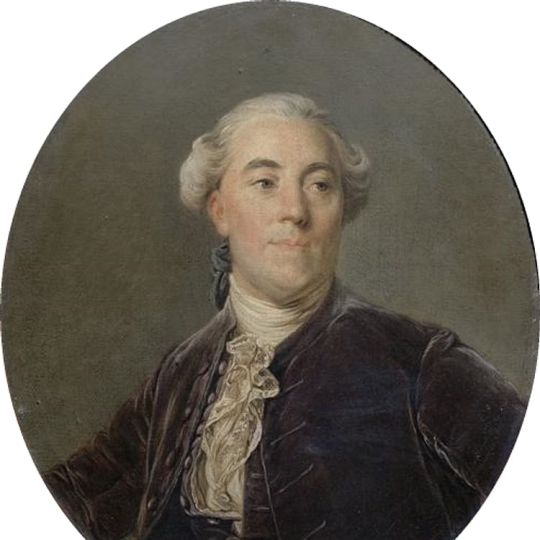
Jacques Necker
Jacques Necker (l. 1732-1804) was a Swiss banker and statesman who served as finance minister to King Louis XVI of France (r. 1774-1792). He served in the king's ministry three separate times, tasked with navigating France through its dire financial crisis. Initially popular amongst the common people, Necker played a significant role in the outset of the French Revolution (1789-1799).
Continue reading...
14 notes
·
View notes
Text
Alexander Hamilton’s financial plan: Adam Smith and other influences
Federalists and anti-Federalists alike thundered about how the government would fund debt, how it would raise revenue and regulate commerce, and how each of these tasks would affect the character of the nation.
Rising to meets these challenges was Alexander Hamilton, Madison’s indefatigable coauthor of The Federalist Papers, Washington’s Treasury Secretary, and precocious finance engineer....He elucidated his elaborate plan to modernize American financial and political institutions across three major works written between 1789 and 1791 [1790 - Report for Provision of Public Credit; 1790 - Second Report on Establishing Public Credit; 1791 - Report on the Subject of Manufactures].
...Wile Hamilton’s objectives in these reports appear in abstract and highly technical language - debt financing, credit creation, discriminatory interest rates, manufacturing subsidies - his overall mission was political. Hamilton was determined to convince the public that the political fate of the nation was inextricably tied to its financial straits, and that only by activating certain powers of the national government would the nation have a viable future. To that end, he set into motions the principles from what was then known as the science of political economy.
Hamilton saturated his three major reports with insights from [political economy]. He had extensively studied works such as David Hume’s Political Discourses (1752), Wydham Beawe’s Lex Mercatoria Redviva (1754), Malachy Postelwayt’s The University Dictionary of Trade and Commerce (1767), Adam Anderson’s Origin of Commerce (1764), James Steuart’s Principles of Political Oeconomy (1767), and Adam Smith’s The Wealth of Nations. Hamilton had consulted the works of Jacques Necker, a Genevan banker and finance minister to King Louis XVI of France, and had relied heavily on the experience and wisdom of Robert Morris, the famed American financier who established the short-lived Bank of North America in 1781.
...In a number of cases, Hamilton simply cribbed from The Wealth of Nations to spell out his economic logic and persuade his readers. [Examples follow, along with several pages of discussion comparing the content in Wealth of Nations and principles of political economy with the contents of AH’s three reports]
Adam Smith’s America: How a Scottish Philosopher became an Icon of American Capitalism by Glory M. Liu (2021).
2 notes
·
View notes
Photo

A WIFE FOR THE PRINCE - CHAPTER TWO (on Wattpad) https://www.wattpad.com/1304502680-a-wife-for-the-prince-chapter-two?utm_source=web&utm_medium=tumblr&utm_content=share_reading Long time ago in the kingdom of Ar, there lived a young handsome prince who was of the marriageable age and his name goes by Necker Hunger-Jacques a very popular and well known man, when he failed to find a wife to bore an heir in his kingdom he was sent to bring his wife within a month. Till the next full moon. Prince Necker saddled his horse and travelled far beyond their coast and reached the land of Fashion and Beauty-Fran and the princess of that land caught the apple of his eyes. Princess Marie Louix was the only daughter in thirteen children born to her parents and luck made her the last of them, she also found favor in their sight and all the kingdom because she was of good character and conduct. Like a rare gem, it was hard to have her has his since she became the daughter to all the kingdom. He was tested till the point were more luxurious bodied women were used as baits. In the long run, the prince was able to return home with his bride to be and in the next full moon they got married and lived happily ever after. ... ... ... ... 'Just kidding, the couples may have lived happily ever after, but this is not their story. King Necker Hunger-Jacques and Queen Marie Hunger-Jacques.' Prince Calonne Hunger-Jacques of Ar, heir to the throne. The prince who do not believe in love nor the act of marriage and that greatly worries his parents who have on several occasions tried to hook their son with someone, but all the time he finds fault in them becoming a criticize and none of them could do so about him if not his mood would be bad. 'How will the kingdom have another heir when they have a whole package as a son? Who is worthy to be his prince Calonne wife?'
#coldheart#disguise#fiction#heir#love#pince#prince#princes#princess#romance#royal#books#wattpad#amreading
2 notes
·
View notes
Text
Press Release by...?
"King Louis XVI kills King George III after a fight broke out between them
After the French royals caved in and returned back to the British monarchy, the British thought they gained an ally. However, the British couldn’t fulfill the promises made to the French King and his followers, angering and leaving a tense relationship between the two. Not long after, a small fight broke out between the French and British monarchies snapping the weakened relationship between the both of them, in anger, King Louis XVI could not bear the relationship between them both and decided to send out an assassination group to kill King George III. Currently, King George has not been MIA, leaving people suspecting his death. Three of his old followers: Marquis De Lafayette, Charles Gravier, and Jacques Necker have stated that this wouldn’t surprise them if the British monarch was dead in the hands of their King due to his previous reckless behavior in the Seven Years war."
0 notes